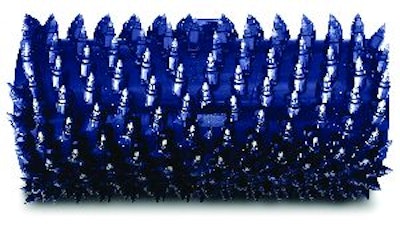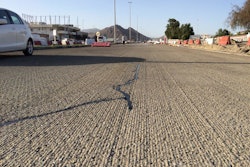
Vibration, excessive heat and silicon dust can bring a $300,000+ milling machine to a grinding halt. With downtime averaging several thousand dollars a day, diligent preventive maintenance and training are wise investments.
The cutter head is subject to the most wear. "Depending upon cutting conditions and the type of machine, tools can last [from] just a few hours up to several days," says Thomas Chudowski, product business manager, global road construction, Kennametal.
"Normally, increased wear is due to aggressive operation without making adjustments to conform to the jobsite and material conditions," adds Philip Taraschi, product specialist, BOMAG Americas Inc.
Watch your speed/depth
Operating speed drives much of the wear. "The speed of operation is critical in calculating wear to the cutter bits, holders and drum of the machine, [as well as] the life you get out of track pads and conveyor belts," says Dennis Munks, The Sollami Company. "Running at maximum speeds reduces the life of every component mentioned and increases vibration, which leads to other costly repairs. Running the machine at excessive speeds is usually the main cause for uneven tool wear."
Heat generation due to excessive speed deteriorates carbide tips. "When you lose the protective carbide, the tooth becomes dull and blunt," says Jeff Wiley, Wirtgen. "That creates vibration and slows the machine down as much as 40%."
In addition, material needs a chance to evacuate. "Massive wear on tools can be caused by not getting cut material out of the housing quickly enough as a result of the machine's cutting depth and/or advance speed," says Chudowski. Material gets re-circulated, causing wear on all components (tools, holder system and even the housing). "Also, water cannot get to the tool, negatively affecting rotation, as well as tool wear."
Inspect often
The cutter head requires constant attention. "Start by checking hourly and adjust the interval based on the wear you are observing," suggests Eric Baker, marketing manager, Roadtec. "Usually, there is a gap in trucks when this can be done."
Visually inspect the cutter teeth and spot-change any that need to be replaced. "Deep cuts in hard asphalt require more frequent inspections, while shallow cuts in soft or deteriorated asphalt will require less," Baker notes.
Taraschi also advocates frequent inspections, along with keeping water systems in good operating condition. "Inspections and water are inexpensive and essential tools, whereas labor and downtime are costly," he points out. If abrasive material wears into the holders, the expense and labor costs increase.
Why tools fail
According to Chudowski, typical tool failures and their causes include:
- Carbide breakage - This can occur when tools are mechanically overloaded (hitting hard objects such as drainage covers or steel reinforcements), or due to thermal overload (excessive heat resulting from insufficient water supplied to the tool).
- Lack of rotation - This can be caused by too much dirt in the holder bore (possibly due to a lack of water supply to the tool) or a worn tool holder.
- Body wear/steel wash - This can be caused by high machine speed in soft (often abrasive) conditions. Reducing machine speed or using a different tool design could help solve the issue.
Poor tool rotation quickly destroys teeth. "When the tooth stops rotating, it creates a flat side," says Wiley. "When it flat sides, it gets hot and fails."
The type of material being milled can impact tool rotation."Material with high asphalt cement (AC) content can cause tools to stop rotating," says Taraschi. "In some cases, it can be corrected by adding low caustic to the water system.
"If tools in a certain position continue to prematurely wear, check impact and skew angle positions," he advises. "If tools become mismatched to the point that the newer tools are wearing faster, clean up the drum with all new tools."
Tool holder condition can also play a big part. "For example, if the face of the holder is worn down, this will mismatch tool impact position," Taraschi indicates, "or holder internal dimensions are worn to the point that it will still hold the tool, but will allow the tool to drastically move out of the intended impact angle."
Faulty water spray systems are another leading cause of uneven tool wear. "The spray pattern must be a fan spray in order to get good coverage," says Wiley. "This system is filtered and you have to keep that system clean."
"Water system faults generally relate to poor system maintenance and/or milling in place without discharging material," says Taraschi. "This allows material to force into spray tips."
Causes of vibration
Vibration needs to be addressed as it arises. The three levels of vibration include low, medium and high cycle.
"High-cycle vibes are normally a pending fault in the engine to drum drive system," says Taraschi. "Medium-cycle vibes are normally a pending fault in the mill drum reduction drive system."
Low cycle are the most common form of drum vibration, he continues. They can result from the ZERO mount bearing (opposite drum drive side) beginning to fail, causing the mill drum to run out of cycle; material buildup inside the left and right drum shell areas from lack of wash-down maintenance, knocking the drum off balance; or missing tool holders or material flight blocks.
Drum vibration can also indicate worn/blunt tools, says Chudowski. If the vibration does not disappear after changing tools, the reason could be related to the drum being balanced incorrectly (or a lost counterweight); improper lacing design; incorrect drum installation; or a machine bearing that needs replacement.
Keep an eye on the product
The pattern behind the milling machine can be a good indicator of when to check the cutter head. "If the surface looks rough, stop the machine and inspect cutter tools and holders," says Munks. Also check bits at least twice daily during operation.
"There are visual checks you should perform every minute of the day," says Wiley. "For example, ground [personnel] have a job of visually inspecting moving parts - tracks, conveyors and, most important, cutter pattern."
The cutter pattern warns of potential issues. "For example, a white streak left behind the machine in the pattern could indicate worn out teeth, or holders that desperately need to be replaced," says Wiley. "Also, highs and lows on teeth and holders can lead to a poor cutter pattern no matter what speed you run the machine. 'Spotting' teeth can create grooves in the pattern that you can't control. Evenness and consistency are important to managing a good, consistent cutter drum and pattern."
Obviously, you can't control all variables that impact tool life. "The life expectancy of cutter tools varies so much depending upon the material being cut," Munks states. "Size of aggregate and compaction of material plays a big part in tool life."
But there are steps you can take to get as much life from tools as possible. "Once the cutter tool becomes blunt, change it before the carbide tip is totally worn down," Munks recommends. "Once the carbide wears away, extensive damage to holders and blocks can happen very quickly and cause major downtime and repairs. Real blunt carbide tips on cutter tools are also a major cause of vibration. Maintain sharp cutter tools throughout the entire drum, and reduce the amount of times you spot new cutter tools on the drum alongside worn cutter tools."
"The idea of every cutting drum system is that the tooth takes the majority of the wear and is the easiest component to replace," says Baker. "If the tooth is no longer there or not taking the wear, then other parts of the system take the wear. The tooth holder on most systems can cost anywhere from four to 10 times as much as the tooth, so you would much rather replace a tooth too soon than replace a holder."
Replacing tools as needed will also minimize any "domino" effect. "Usually, when one tooth fails, the tooth closest to that one in the pattern fails next and so on," says Wiley. "They all work together."
The size of the carbide on the tip of the tool can impact horsepower and production of the milling machine, as well, Munks points out. "Smaller horsepower machines generally need a sharper, smaller carbide tip on the cutter tool for better penetration, and it will reduce vibration," he explains. "Good penetration of the material being milled is a key factor in getting the most production out of any machine."
Use the right tools
"Cutting teeth are the No. 1 operating cost for a milling machine, so any improvements in consumption can be the difference between success and failure," says Baker. "Part of the equation is to match the two main components of the tooth - carbide and steel - to the application."
Premature failure is normally due to using the incorrect tool type, horsepower per tool impact rating and/or carbide and base structure for the material conditions, says Taraschi. "The life of a tool depends on having the correct tool matching unit horsepower to material conditions," he emphasizes.
"Today, a milling contractor might have as many as five different tooth models in his inventory to address every application in his portfolio," adds Wiley.
Taking the time to speak with tool manufacturers to ensure a good match (unit horsepower to regional material) will result in better production and longer tool life. "If you opt to install inadequate tools per unit horsepower to material, the results will be more costly due to frequent tool replacement and longer unit downtime," says Taraschi.
A tool that's too small for the application or machine won't last long. "A tool too big for a low-horsepower machine slows down the machine," says Chudowski. "The life of the tool might be extended, but the efficiency of the machine is unacceptable (not economical)."
That said, there are times when a faster and smaller tool may be better to improve the overall efficiency of the total operation - for example, when the paving operation is directly behind the milling operation.
Material density also plays a role in tool selection. "If you are going to be cutting a looser material, you might need more steel to prevent the loose material from washing out the steel before the carbide is used," says Baker. "If you are cutting harder material, such as concrete, you would probably want more carbide, since there will be more impact wear."
Another part of the equation is tooth shape or geometry. "Some teeth have a steeper slope for more penetration, while others are more blunt," says Baker. "Proper selection is dependent on the type of material to be cut. The best way to find out which is best is with experience, but the tool manufacturers also have a lot of expertise they can provide to help in the selection."





















